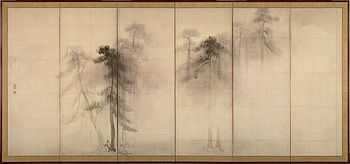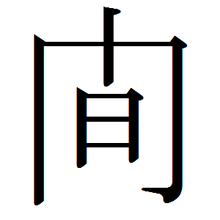Ma (negative space)

Ma (間) is a Japanese word which can be roughly translated as "gap", "space", "pause" or "the space between two structural parts."[1][2][3][4] The spatial concept is experienced progressively through intervals of spatial designation. In Japanese, ma, the word for space, suggests interval. It is best described as a consciousness of place, not in the sense of an enclosed three-dimensional entity, but rather the simultaneous awareness of form and non-form deriving from an intensification of vision.
Ma is not something that is created by compositional elements; it is the thing that takes place in the imagination of the human who experiences these elements. Therefore ma can be defined as experiential place understood with emphasis on interval.[5]
Word
Among English loanwords of Japanese origin, both Ma (negative space) and Ken (architecture) are written with the same character 間.
This Japanese kanji "Chinese character" 間 graphically combines 門 "door" and 日 "sun". The earlier variant character 閒 was written with 月 "moon" rather than "sun", depicting "A 門 door through the crevice of which the 月 moonshine peeps in".[6]
The diverse Japanese pronunciations of 間 include on'yomi Sino-Chinese readings (from jian 間 or 间 "room; between; gap; interval") of kan "interval; space; between; among; discord; favorable opportunity" or ken "six feet"; and kun'yomi native Japanese readings of ai "interval; between; medium; crossbred", aida or awai "space; interval; gap; between; among; midway; on the way; distance; time; period; relationship", or ma "space; room; interval; pause; rest (in music); time; a while; leisure; luck; timing; harmony".[7]
Usage in the West

In his 2001 book The Art of Looking Sideways, Alan Fletcher discusses the importance of exemplifying "space" as a substance:
Space is substance. Cézanne painted and modelled space. Giacometti sculpted by "taking the fat off space". Mallarmé conceived poems with absences as well as words. Ralph Richardson asserted that acting lay in pauses... Isaac Stern described music as "that little bit between each note - silences which give the form"... The Japanese have a word (ma) for this interval which gives shape to the whole. In the West we have neither word nor term. A serious omission.[8]
Thomas Pynchon's book The Crying of Lot 49 stresses the concept of waste in language, in terms of negative space determining outcomes of actual events.
Derrick de Kerckhove described Ma as: “the complex network of relationships between people and objects”[9]
See also
- Maai
- Mind the gap, warning phrase issued to London Underground passengers
- Mu (negative)
- Wu wei, a term in Chinese philosophy
- Negative space
- Liminality
- The Void (philosophy)
References
- ↑ Japanese language definition
- ↑ http://forums.gardenweb.com/forums/load/jgard/msg100248139141.html
- ↑ http://www.artlex.com/ArtLex/Ne.html
- ↑ http://www.mfj-online.org/journalPages/MFJ38/iimura.html
- ↑
- ↑ Bernhard Karlgren, Analytic Dictionary of Chinese and Sino-Japanese, Paul Geunthner, 1923, p. 130.
- ↑ John H. Haig, The New Nelson Japanese-English Character Dictionary, Tuttle, 1997, p. 1132.
- ↑ The Art of Looking Sideways. by Alan Fletcher. Page 370. Published by Phaidon, 2001. ISBN 0-7148-3449-1.
- ↑ de Kerckhove, Derrick, "The Skin of Culture," in "Marshall McLuhan: Theoretical elaboration", Volume 2, Taylor & Francis 2005. p 157.